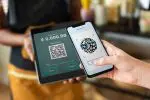QR codes. Those little black-and-white squares are everywhere on restaurant menus, product packaging, and even business cards. But here’s what most people don’t realize use QR codes: they’re not just convenient – they’re changing the game for small businesses in ways we never imagined.
Impact of QR code payments on small businesses. Picture this: A bustling farmers market. A young couple spots a hand-knitted scarf they love. Instead of fumbling for cash or swiping a card, they simply scan a QR code with their phone. Transaction complete in seconds. The vendor? A small business owner who just made their 50th sale of the day – double their usual.
So, are you ready to discover how a simple square of pixels could transform your small business in ways you never thought possible?
Boost customer satisfaction with just a few clicks
Most-Loved Features:
- On-demand drivers
- Real-time GPS tracking
- Delivery confirmation photos
- Over 50% of customers report a smoother delivery experience
Benefits of QR Code Payments for Small Businesses
-
Cost-saving: Reduce transaction fees compared to traditional methods.
-
Fast and easy: Quick transactions improve the customer experience.
-
More sales: Attract new tech-savvy customers.
Cost-Effective Payment Solution
In 2024, small businesses saw a significant rise in QR code payments as a cost-saving solution. Business owners quickly realized that QR code payment systems often come with lower transaction fees than credit card processing. Transaction fees for QR codes can be as low as 1% per transaction, compared to around 2% to 3% for credit cards. This difference adds up, especially for businesses with high sales volume. A small business processing $10,000 monthly could save hundreds of dollars a year.
More payment processing companies began to offer QR code payment solutions, leading to competitive pricing. Businesses not only benefited from reduced fees but also gained access to better financial terms and conditions. By the end of 2024, many small businesses saw up to a 20% increase in revenue solely due to transaction fee savings. This trend is expected to continue in 2025, with even more providers entering the market and offering competitive rates.
Convenience and Speed
The rise in contactless payments during 2023 made QR code payments even more attractive. Customers enjoy the convenience of using their smartphones to scan the code and pay in seconds. This quick process led to shorter lines and enhanced customer satisfaction. Business owners noted less time spent handling cash, which allowed them to more focus on customer service and operational tasks.
Businesses installed QR code systems faster than expected throughout the year, due to the minimal infrastructure required. All it took was a QR code sticker or sign, making it easy and cheap to set up compared to other digital payment methods. Businesses that adopted QR code payments reported a faster service speed, often cutting transaction times by half. This increase in efficiency contributed to improved customer flow and satisfaction.
The next year holds even more potential for increased convenience. As smartphone technology advances, QR code scanning will become almost instantaneous, further speeding up transactions. Businesses should prepare to leverage these advancements to maximize customer interaction efficiency.
Increased Sales Opportunities
The adoption of QR code payments in 2023 increased sales opportunities for small businesses. It attracted digital-native consumers who value frictionless payment experiences. Customers became more likely to spend when the payment method was easy and barriers were low.
The trend also captured more international business, as tourists increasingly used QR code payments, familiar and widely used in their home countries, avoiding the hassle of currency exchange. This broad acceptance created a new revenue stream for small shops catering to foreign visitors. By year’s end, businesses reported up to a 15% increase in sales volume, attributable to new customer segments enabled by QR codes.
Looking at 2024, the potential for increased sales remains strong. Predictions suggest the continued rise of e-wallets accepting payments, often using QR codes behind the scenes, will bring in more users and create fresh opportunities for small businesses. Accepting these payments can be a game-changer. Businesses need to consider promoting their QR payment capabilities to consumers unfamiliar with the technology to maximize these opportunities.
QR Code Payment Integration in Small Business: A Step-by-Step Guide
Step 1: Choose a QR Code Payment Provider
Selecting the right payment provider is crucial for the success of QR code payments in your business. Look for providers that offer reliability, competitive fees, and strong customer support. Do they support multiple currencies, or are they limited to a specific region? Is there a setup fee or a monthly service fee? Make sure these details fit your business needs.
Step 2: Set Up Your Account
Once you’ve selected a provider, setting up your account is the next step. Visit the provider’s website and initiate the registration process. You will need to provide basic information about your business, such as the business name, address, and tax identification number. Some providers may require a valid email address and phone number for verification purposes.
After submitting the initial information, most providers will request documentation to verify your business. This might include your business registration certificate, a government-issued ID, and bank account details. The verification process can take a few hours to several days, depending on the provider, so plan accordingly.
Step 3: Generate QR Codes
Once your account is set up and verified, you can start generating QR codes. Most payment platforms provide an interface for creating QR codes, often found in the settings or merchant tools section. You will typically need to specify details like the amount to be paid or a description of the item or service when generating each code.
Customizing your QR codes is an opportunity to strengthen your brand. Some providers offer options to personalize the design of the QR code by adding your logo or incorporating your brand colors. These details can make your QR codes more recognizable and can enhance customer trust. Always check if these options are available and compatible with your provider.
Step 4: Train Your Staff
Training your staff is essential for the smooth rollout of QR code payments. Ensure everyone understands how the system works, from generating codes to troubleshooting minor issues like incorrect scans. It is better to create a step-by-step manual and conduct demonstrations to get your team comfortable with every aspect.
You should begin with clear objectives for the training, and use simple language to explain processes. Encourage questions to address any uncertainties. Role-playing can be effective, allowing staff to practice transactions as both the customer and the employee. Regular updates or refreshers can help maintain skills and remind staff of any new features or changes.
Step 5: Promote and Accept QR Code Payments to Customers
After integrating QR code payments, let your customers know. You should use clear signage at checkout points, detailing how QR code payments work. You can consider adding a small incentive at the checkout counter for customers who use the new system, such as discounts or special offers.
Digital communication is equally important. Send out emails and update your website and social media channels to inform existing customers. Demonstrate the benefits of QR code payments, emphasizing security and ease of use. Visual aids or short clips can visually demonstrate the process, making it clear and inviting to tech-savvy and hesitant customers.
QR Code Payment Trends in 2024 and How to Leverage Them
The Rise of Contactless Payment Demand
Trends from the Past 12 Months
QR code payments have become more popular over the past year. Since late 2023, people have been using contactless payment more often. This was not just happening in one place. It was happening all over the world. In November 2023, reports showed that more than 50% of consumers preferred contactless payments for their daily purchases. As studies reflect, this trend has remained steady into 2024 as people continue avoiding cash due to hygiene concerns from previous pandemics. Discover how implementing payment solutions via QR codes can enhance operational efficiency and elevate the shopping experience for your customers.
By January 2024, more small businesses noticed this shift. Many who hadn’t yet offered QR code options started doing so. The transition isn’t complex, encouraging adoption faster. In April, it was reported that contactless payments made up 70% of in-store transactions. Small businesses benefit because these payments can be processed faster than cash or card. It saves time for businesses and customers alike.
The Influence of Mobile Commerce
Evolution of Mobile Usage and Payments
Mobile commerce isn’t new, but the integration with QR payments has seen changes this year. By March 2024, the share of mobile device sales in online retail reached 75%. QR codes made mobile payments even smoother. Buyers just need their phones.
From May to September, social media platforms and digital marketplaces started using QR more too. They offered QR as a way to purchase straight from their apps. This change helps small businesses because customers spend more time on their devices.
Strategic Recommendations for 2024
To attract these mobile-driven customers, enhance your online presence. It’s essential that purchasing via mobile is easy. You should be sure the checkout page on your website or online store supports QR payments. Provide QR options on your social media.
Why QR Code Payments Will Keep Growing This Year
The Market and Technology Landscape
By June 2024, many large companies revealed their plans to scale QR payment infrastructure. Tech giants are improving their systems to support faster and more secure QR code transactions. This push indicates a broader payment industry shift.
Banks and financial institutions are also supporting businesses that embrace these technologies. From August, incentives for financial inclusion like reduced fees were introduced to businesses using QR payments. This adds more reason for small enterprises to adapt quickly.
QR Code Payment Security for Small Businesses
Common Security Concerns and Misconceptions
When it comes to QR code payments, small business owners often worry about security. Two big concerns are QR code manipulation and tampered codes. These can redirect users to harmful sites or fake portals, exposing personal information to cybercriminals. Such accusations make it seem like QR codes are a risky choice for payments.
But let’s clear some things up. Not all QR codes are dangerous, and there are many ways to protect users. Misconceptions arise from a lack of understanding. For example, some think QR codes can be easily read and hacked just by scanning. However, QR codes mainly provide URLs or simple text. They don’t directly store sensitive information like card numbers.
The truth is, that QR code security relies on how businesses use them. Knowing the risks is critical, but understanding the preventative measures is even more important. We can now focus on how QR codes stay secure.
How QR Code Payments Ensure Security
QR code technology provides several layers of security that reduce risks. One of the primary ways is through encryption. By using SSL certificates, businesses ensure safe connections, securing data transfer between the user’s device and the payment processor. This process guards against unauthorized access.
Secure scanners with advanced features play a big part too. They verify URLs and warn users about potential threats. Such scanners can significantly lower the chances of falling victim to traps involving manipulated QR codes. Multi-factor authentication adds another layer of security to prevent unauthorized access.
However, no system is foolproof. While QR codes are generally safe, remaining vigilant is crucial. Always use secure networks and verified QR code readers. Encouraging customers to remain mindful of the apps they use can help, as mobile defense systems identify and prevent unsafe downloads.
Tips for Enhancing Payment Security
Small businesses need to focus on enhancing the security of their QR code payment systems. Here’s how:
-
Choose a Reliable Payment Provider: Ensuring the provider has a strong reputation is crucial. Providers like Stripe or Square prioritize secure transactions and offer robust support systems.
-
Conduct Regular Security Audits: Routine checks of the QR code payment system help identify vulnerabilities early. This practice enhances operational security by ensuring software is up-to-date and free from known issues.
-
Educate and Train Staff: Knowledgeable staff are one of the best defenses against security breaches. Regular training sessions familiarizing employees with potential threats and security best practices are invaluable.
-
Use Secure Networks: Payments via public Wi-Fi networks are riskier. Ensure transactions are carried out over secure and encrypted networks to prevent data interception.
-
Customer Education: Inform customers about secure QR code usage. Guides on recognizing secure QR payment gateways can prevent them from falling into traps set by cybercriminals.
Why Use QR Code Payments for Small Businesses?
Understanding QR Code Payments
QR code payments involve the simple act of scanning a unique square barcode with a smartphone. This process lets customers pay instantly and securely. Gone are the days of typing in long card numbers. Now, they simply use their phone’s camera. No specialized apps or gear are required. This simplicity makes QR code payments way easier for both customers and businesses. Discover how implementing payments via QR codes can elevate your business, offering a straightforward and secure transaction method for your clients.
For small businesses, QR code payments reduce the need for costly point-of-sale (POS) systems. A small coffee shop, for example, can set up a system where customers scan a QR code to pay without interacting with a cashier. This can lead to faster transactions and shorter lines, which can attract more customers during busy hours.
Evolution of Payment Methods in Recent Years
In recent years, we’ve seen a steady decline in cash usage in favor of digital payments. This shift isn’t just a trend—it’s driven by consumer preference, convenience, and the need for faster transactions. The pandemic catalyzed this trend, with cashless transactions becoming essential for hygiene. This has led more businesses to adapt from traditional payment methods to digital payments to meet evolving customer needs.
For payment page, for instance, many farmers’ markets have started accepting QR code payments. By doing this, vendors cater to tech-savvy customers who prefer not to carry cash while still keeping transaction times quick and seamless. It’s also beneficial for small business owners who want to avoid dealing with cash handling and theft.
While QR code payments are gaining traction, some customers still prefer physical cash. Ensuring a variety of payment options can serve wider customer needs and help businesses balance between traditional and digital methods to process payments.
Impact of QR Code Payments on Small Businesses
QR code payments are reshaping small business landscapes. They offer cost-effective, swift transactions that boost sales and customer satisfaction. By following the integration steps, from choosing a provider to staff training, businesses can smoothly adopt this technology. The rising trends in contactless payments position QR codes for significant growth in 2024.
Security concerns are valid, but modern QR systems provide robust protection. As cash use declines and digital payments soar, small businesses must adapt to stay competitive. The future of payments is digital, and QR codes are at the forefront.
Your next move? Pick a QR payment provider today. Set up your account, create your first code, and train one staff member. Then, watch as your business transforms. Remember, every scan is a step towards growth. In a world where convenience rules, QR payments aren’t just another payment option—they’re your ticket to staying relevant and thriving in the digital age. Are you ready to scan your way to success?













